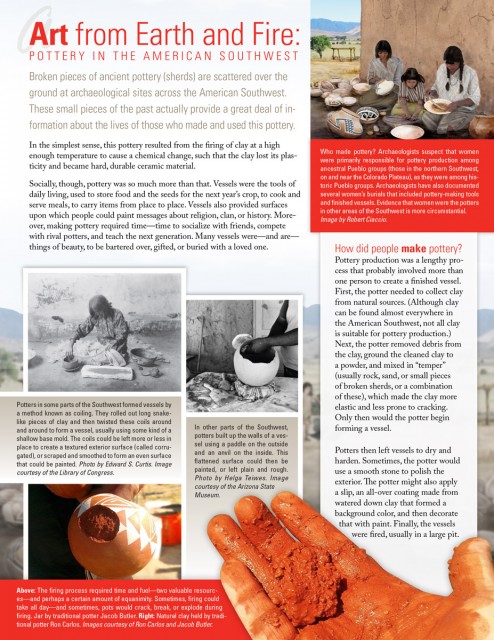Banner pottery images courtesy of Eastern Arizona College

Broken pieces of ancient pottery (sherds) are scattered over the ground at archaeological sites across the American Southwest. These small pieces of the past actually provide a great deal of information about the lives of those who made and used this pottery.
In the simplest sense, this pottery resulted from the firing of clay at a high enough temperature to cause a chemical change, such that the clay lost its plasticity and became hard, durable ceramic material.
Socially, though, pottery was so much more than that. Vessels were the tools of daily living, used to store food and the seeds for the next year’s crop, to cook and serve meals, to carry items from place to place. Vessels also provided surfaces upon which people could paint messages about religion, clan, or history. Moreover, making pottery required time—time to socialize with friends, compete with rival potters, and teach the next generation. Many vessels were—and are—things of beauty, to be bartered over, gifted, or buried with a loved one.
How did people make pottery?
Pottery production was a lengthy process that probably involved more than one person to create a finished vessel. First, the potter needed to collect clay from natural sources. (Although clay can be found almost everywhere in the American Southwest, not all clay is suitable for pottery production.) Next, the potter removed debris from the clay, ground the cleaned clay to a powder, and mixed in “temper” (usually rock, sand, or small pieces of broken sherds, or a combination of these), which made the clay more elastic and less prone to cracking. Only then would the potter begin forming a vessel.
Potters then left vessels to dry and harden. Sometimes, the potter would use a smooth stone to polish the exterior. The potter might also apply a slip, an all-over coating made from watered down clay that formed a background color, and then decorate that with paint. Finally, the vessels were fired, usually in a large pit.
How do archaeologists study pottery?
Archaeological studies of pottery reflect the questions we have about the past and the ways pottery may help us address those. Some archaeologists analyze form, identifying different kinds of bowls and jars. Many archaeologists examine the designs on decorated pottery, recording symbols and color combinations and overall design layouts. Some archaeologists study the residue left on pottery to identify what people stored or cooked in a vessel. Technological analyses provide information on how the pottery was made—what clays were used, how hot the fire was, what kinds of paints were used. Chemical and mineralogical studies provide data on where pottery was made.
What does pottery tell us about the past?
Pottery studies can tell us what foods were cooked, eaten, or stored. Specific combinations of colors and designs can tell us when (more or less) people made and used the pottery and associated artifacts, helping us to date dwellings and villages. We can learn more about who made pottery in certain times and places: was it women in every household, a few specialists within each village, or even specific pottery-making villages? Designs on pottery sometimes reveal how people viewed their world and themselves. Some designs encode information about lineages and ethnicity, and others depict specific aspects of daily life, including hunting techniques, births, religious rites, and use of animals. The distributions of different kinds of pottery can tell us about social networks and exchange relationships and how those changed through time.
What should I do if I find pottery, especially on my property?
When pottery is moved from where it was found without proper documentation of the location and surrounding context, important information is often lost. Certain questions pottery can address require this information.
First, be aware that it is illegal to remove pottery—whole vessels or sherds—from public lands, such as national parks, monuments, and forests, as well as from state or municipal lands, without the proper permits.
If you find a few sherds in your yard, a local college, historical society, archaeological society, or museum might be able to help you identify them in person or via email. You can also compare them to online collections by starting here: http://swceramics.mattpeeples.net/.
If you have so many sherds on your property that you suspect or know that a site is present, you are under no obligation to contact archaeologists, but at minimum, we ask that you enjoy, preserve, and protect what is there in place. If you’d like us to help you identify the sherds, document the site, or advise you on how to protect the remains, please contact us at info@archaeologysouthwest.org. Many times, it is helpful just to learn that a site with certain cultural traditions is present in a place.
Want to learn more? Explore the major concepts, places, cultures, and themes that Southwestern archaeologists are investigating today in our Introduction to Southwestern Archaeology.